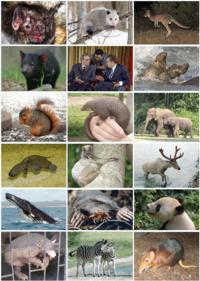colspan=2 style="text-align: center; background-color: transparent; text-align:center; border: 1px solid red;" | MammalsTemporal range: Middle Jurassic - Present, 167.7–0Ma PreЄ Є O S D C P T J K 275px Examples of various mammalian orders, click the image and scroll down for individual descriptions colspan=2 style="text-align: center; background-color: transparent; text-align:center; border: 1px solid red;" | Scientific classification e</small> Kingdom: Animalia Phylum: Chordata Superclass: Tetrapoda Clade: Amniota Clade: Mammaliaformes Class: Mammalia colspan=2 style="text-align: center; background-color: transparent; text-align:center; border: 1px solid red;" | Subgroups Clade Australosphenida †Order Ausktribosphenida Order Monotremata †Order Eutriconodonta †Order Gobiconodonta †Order Multituberculata Clade Trechnotheria Subclass Theria Infraclass Marsupialia Infraclass Placentalia Mammals are a clade of warm-blooded amniotes. Among the features that distinguish them from the other amniotes, the reptiles and the birds, are hair, three middle ear bones, mammary glands in females, and a neocortex (a region of the brain). The mammalian brain regulates body temperature and the circulatory system, including the four-chambered heart. The mammals include the largest animals on the planet, the rorqual whales, as well as some of the most intelligent such as elephants as well as some primates and cetaceans. The basic body type is a four-legged land-borne animal, but some mammals are adapted for life at sea, in the air, in the trees, or on two legs. The largest group of mammals, the placentals, have a placenta which feeds the offspring during pregnancy. Mammals range in size from the 30–40 millimeter (1- to 1.5-inch) bumblebee bat to the 33-meter (108-foot) blue whale. The word "mammal" is modern, from the scientific name Mammalia coined by Carl Linnaeus in 1758, derived from the Latin mamma ("teat, pap"). All female mammals nurse their young with milk, which is secreted from special glands, the mammary glands. According to Mammal Species of the World, 5,702 species were known in 2006. These were grouped in 1,229 genera, 153 families and 29 orders. In 2008 the IUCN completed a five-year, 17,000-scientist Global Mammal Assessment for its IUCN Red List, which counted 5,488 accepted species at the end of that period. In some classifications, the mammals are divided into two subclasses (not counting fossils): the Prototheria and the Theria, the latter composed of the infraclasses Metatheria and Eutheria. The marsupials comprise the crown group of the Metatheria and therefore include all living metatherians as well as many extinct ones; the placentals likewise constitute the crown group of the Eutheria. Except for the five species of monotremes (which lay eggs), all living mammals give birth to live young. Most mammals, including the six most species-rich orders, belong to the placental group. The three largest orders, in descending order, are Rodentia, Chiroptera (bats), and Soricomorpha. The next three largest orders, depending on the classification scheme used, are the primates, to which the human species belongs, the Cetartiodactyla, and the Carnivora. While the classification of mammals at the family level has been relatively stable, different treatments at higher levels—subclass, infraclass, and order—appear in contemporaneous literature, especially for the marsupials. Much recent change has reflected the results of cladistic analysis and molecular genetics. Results from molecular genetics, for example, have led to the adoption of new groups such as the Afrotheria and the abandonment of traditional groups such as the Insectivora. The early synapsid mammalian ancestors were sphenacodont pelycosaurs, a group that also included Dimetrodon. At the end of the Carboniferous period, this group diverged from the sauropsid line that led to today's reptiles and birds. Preceded by many diverse groups of non-mammalian synapsids (sometimes referred to as mammal-like reptiles), the first mammals appeared in the early Mesozoic era. The modern mammalian orders arose in the Paleogene and Neogene periods of the Cenozoic era.




Comment
0